History
The use of mechanical controls for invasive aquatic plants began in response to the growing threat of water hyacinth throughout the southeast, especially in Florida and Louisiana. In 1899, the United States Rivers and Harbors Act authorized the construction and operation of “crusher boats” to remove water hyacinth from navigable waterways. Three years later the Rivers and Harbors Act Amendment allowed for the extermination of water hyacinth by mechanical, chemical, or any other means.
In the first half of the 20th Century, plant managers explored the use of chemical control methods, but the technology was in its infancy. Subsequently, most were rejected because of their ineffectiveness or toxicity to non-target species. This resulted in almost exclusive use of mechanical methods such as crusher boats, destruction (saw) boats, elevators and harvesters.
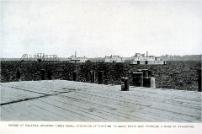 |
Three small steamers attempt to make their way through water hyacinth on St Johns River.
Crusher boats, or Kennys were used in Florida to control water hyacinth until the late 1940s. The machines hauled plants aboard, crushed them under 40,000 pounds of pressure per square inch, and discharged them back to the water or onto shore. Discharge back to the water was the most likely method since shore disposal was inhibited by shallow water, dense tree growth, or the protests of waterfront landowners.
|
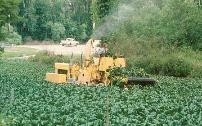 |
Hi-ballers collected plants, ground them up, and fired the plant slurry to the shore with built-in water cannons.
Hi-ballers were a variation of crusher boats. These floating machines collected plants, ground them up, and used a water-cannon to fire the plant slurry to the shore. Hi-ballers were used mainly for canal maintenance in remote areas. Obviously, the use of Hi-ballers was possible only where shoreline owners would allow the disposal of ground up plants on their property.
|
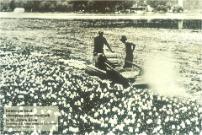 |
Destroyer boat chopping water hyacinth in the St Johns River.
Destruction boats or saw boats were used in the 1940s to control water hyacinth. They were able to operate in shallower water and closer to shore than crusher boats. The saw blades cut close to the surface and were able to shred water hyacinth without lifting them out of the water. Still, the inability to access all plants along the shoreline allowed continued growth and quick reinfestation of water hyacinth. Destruction boats were precursors to today’s modern shredders.
|
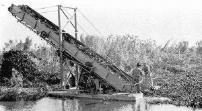 |
Physical control of water hyacinth in the early 1900’s.
Elevators or conveyors have been used since the early 1900s to lift water hyacinth and other plant or organic material onto barges, shorelines or awaiting dump trucks for disposal. Early devices used physical labor or water currents to deliver water hyacinth to the base of the elevator. Later designs used boats or tugs to push water hyacinth to the conveyor. In other cases, conveyors were installed on floating platforms that navigated to target plants and lifted them onboard for later disposal – a technology that is still used in modern harvesters.
|
Then as now, mechanical harvesters alone could not keep pace with the exponential growth of invasive aquatic plants in Florida waters. Research efforts continued to look for more cost-effective and environmentally compatible means to manage plants like water hyacinth and by the 1950s, an array of chemical and mechanical tools had been developed and refined. Today resource managers in Florida and throughout the U.S. rely on an advanced generation of methods and use an integrated approach to control invasive plants. See below for other interesting mechanical control technologies tested in Florida waters.
Mechanical Controls Available Today
Although historic implements are still used in certain situations, mechanical control methods have evolved to accommodate greater access and effectiveness. The following is a basic description of current mechanical control technology. For a detailed discussion of management considerations, including environmental impacts and permit requirements related to each of these methods, see Section 4.
Cutters
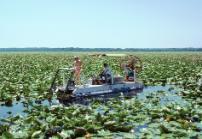 |
Cutting Water Lily to maintain a boat trail on Lake Miccosukee (ca 1977)
Mechanical weed cutters sever aquatic plants a few feet below the water surface. Unlike harvesting, cut vegetation is not immediately collected by the cutting machine. Plants are separately collected on-site or when they collect on the shoreline or downstream. Cutters are usually small since they do not store plants onboard, and can therefore operate in shallow areas and under low obstructions like trees and bridges.
|
Harvesting
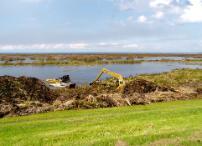 |
Pushing cattail, uprooted by Hurricane Wilma, to shore for harvesting by track hoe, on the south shore of Lake Okeechobee (2005)
Harvesters cut vegetation, remove it from the water with a conveyor system, store the material onboard, and transport it to disposal sites. Harvesters operate in depths from one to eight feet deep. A variety of machines are available with cutting swath widths ranging from five to twelve feet wide and capable of hauling up to 10 tons per load. Densely packed water hyacinth can weigh 200 tons per acre. The sequence of short videos depicts harvesting dense mats of invasive Ludwigia grandiflora from Lake Toho.
Track hoes and draglines are large shovel machines. Draglines use a large cable system to cast and drag a shovel that collects plants and organic material. Track hoes have claw shovels that can reach 25-30 feet over the waterbody, dig down, and pull plants back to shore. Shore-based track hoes or draglines are best suited to canal maintenance, or in areas where plants collect, and/or where they can be pushed to an established collection point.
|
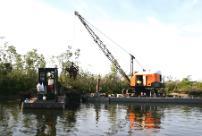 |
Harvesting floating islands of trees up to 40 feet tall and organic sediments four feet thick set adrift in Lake Pierce after Hurricane Charley (2004)
When more mobility is needed, barge-mounted track hoes or draglines can be used for transportation to off-shore control sites. In that case, plants are loaded on an attending barge and hauled to the disposal site.
|
Disposal
 |
Disposing of organic material from floating islands harvested from Lake Runnymeade (ca 2005)
The sheer weight and bulk of harvested plants and organic material presents a significant disposal problem during mechanical control operations. Resource managers are required to obtain permits and permissions from governing agencies and landowners, plus handle the logistics of transporting and off-loading the material.
To increase efficiency, separate shuttle barges are sometimes used to transport cut material while the harvester continues working. On-site disposal requires state and federal permits, and the project manager must weigh the benefits of time and cost savings against potential detriments like loss of habitat, reduced water quality, and diminished navigation and aesthetics. For land disposal, material may need to be hauled in sealed dump trucks to prevent water from spilling onto highways, or spread and dried, then reloaded into trucks for hauling. Woody material may need to be separated and chipped or burned. Organic material may need to be piled at the final disposal site until dry and then spread and seeded with grass.
|
Cutters
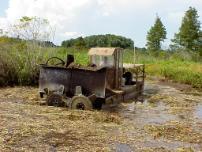 |
Shredding floating islands from Tsala Apopka in about five feet of water (ca 2006)
Shredders use spinning or rotating blades to cut, chop, slurry, or as the name implies, shred aquatic vegetation and other organic material. Most shredders operating in Florida employ two bow-mounted, vertical, counter rotating blades to cut up floating masses of plants (tussocks) or floating islands of peat or muck and associated woody plants. Material is shredded finely enough that it quickly falls to the bottom and decomposes, or is shredded coarsely and harvested from the surface.
|
Putting it all Together
While herbicides have replaced most mechanical controls for invasive aquatic plant management in Florida waters, there are occasions when mechanical control is the only option. For example, vegetation sometimes needs to be removed quickly from flood control structures, bridges, or navigation channels, and when managing freely drifting floating islands of peat or muck on which herbicides and biological controls have no immediate effect. Read about the essential role that mechanical controls play in management of tussocks and floating islands in Florida waters.










